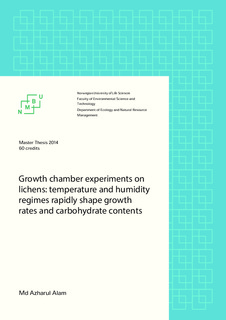| dc.description.abstract | This study assesses relative growth rates and carbohydrate contents of three lichen species under different temperature and humidity regimes in a short-term growth chamber experiment. Representatives from three functional groups: chlorolichens (Parmelia sulcata; green algal), cyanolichens (Peltigera canina; cyanobacterial) and cephalolichens (Peltigera aphthosa; green alga + cyanobacteria) were cultivated for 14 days (150 µmol photon m-2 s-1; 12 h photoperiod) at four temperature regimes (28/23 °C, 20/15 °C, 13/8 °C, and 6/1 °C; day/night temperatures) and two hydration regimes (12 h day-time hydration; 12 h day-time + 12 h night-time hydration). These lichens showed much higher growth than earlier reported, particularly at 13/8 °C. A two-way ANOVA with temperature, humidity regimes as factors and specific thallus mass as a co-variate explained 57.8, 53.2 and 38.1 % of the variation in RGR for P. aphthosa, P. canina and P. sulcata, respectively. Significantly higher relative biomass (RGR) as well as thallus area growth rates (RTAGR) were recorded when the thalli were hydrated day and night compared to hydration in day-time only in all species. Chronic photoinhibition was substantial in P. apthosa and P. canina when kept at lowest temperature regimes and also for the thalli kept dry at night, whereas P. sulcata was photoinhibited at the highest temperature for thalli kept dry at night. Strong, positive linear regressions occurred between RGR and maximal PSII efficiency (Fv/Fm) in all species. Metabolic activity at night improved recovery of photoinhibition and/or may enhance the conversion rate of photosynthates into thallus growth. Moreover, the carbohydrate pools in all the species were measured through HPLC. Unlike the dynamic growth patterns, carbohydrate concentrations varied little with temperature and humidity regimes. After 14 days cultivation, total carbohydrate pool decreased in P. aphthosa and P. canina, but slightly increased in P. sulcata. Mannitol occurred in all the species. Quantitatively, the largest carbohydrate pool was mannitol, glucose and arabitol for P. aphthosa, P. canina and P. sulcata, respectively. The RGR was significantly correlated with photobiont carbohydrate in all species. | nb_NO |
